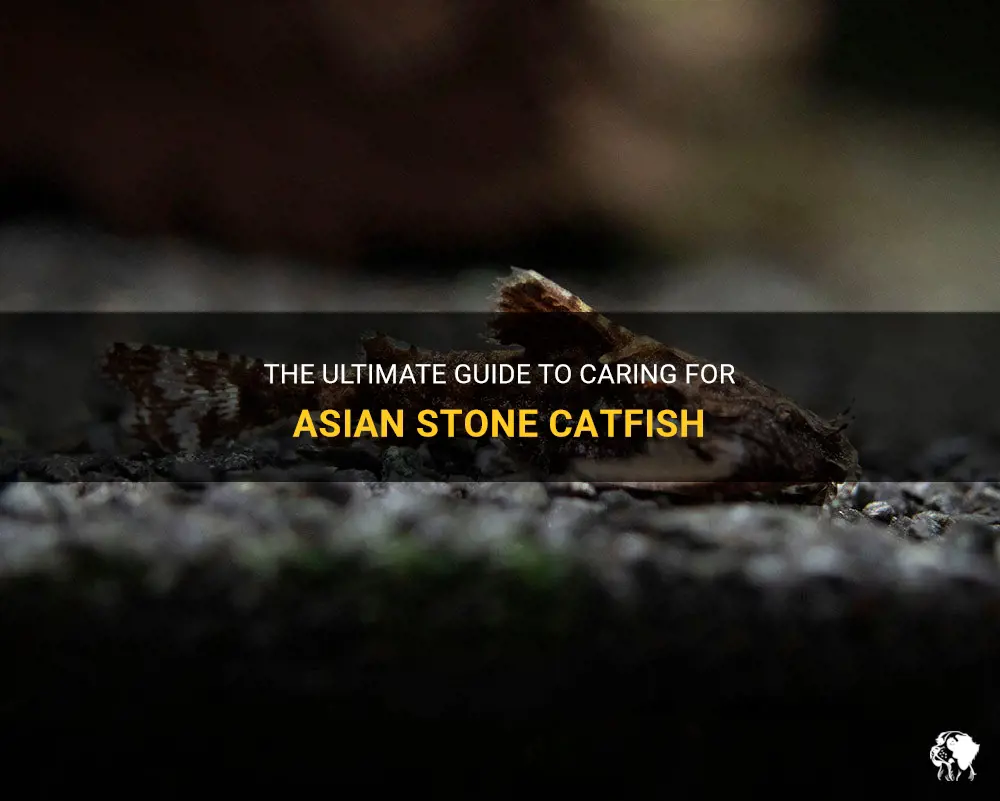
Are you considering adding an Asian stone catfish to your aquarium collection? These unique and fascinating creatures make a captivating addition to any tank. However, before you jump in, it's important to understand the care requirements of these catfish to ensure their well-being and longevity. From their dietary needs to the ideal tank setup, this guide will provide you with all the necessary information to successfully care for an Asian stone catfish. So, get ready to dive deep into the world of aquatic pet care and discover the secrets to keeping these elusive and enchanting fish thriving in your aquarium.
| Characteristics | Values |
|---|---|
| Scientific Name | Hara jerdoni |
| Common Name | Asian Stone Catfish |
| Family | Bagridae |
| Origin | India |
| Size | Up to 2 inches (5 cm) |
| Lifespan | 3-5 years |
| Temperament | Peaceful |
| Tank Level | Bottom dweller |
| Diet | Omnivorous |
| Water Conditions | pH 6.5-7.5; Temperature 72-78°F (22-26°C) |
| Tank Size | Minimum 10 gallons |
| Tank Region | Bottom |
| Compatibility | Suitable for most community tanks |
| Care Level | Easy |
| Activity | Nocturnal |
| Gender Differences | Males have thicker pectoral fins |
| Breeding | Egg scatterer, difficult to breed in captivity |
| Diseases | Susceptible to typical freshwater fish diseases |
| Tank Mates | Small, peaceful fish |
| Plants | Provide hiding places with live or artificial plants |
| Decor | Use sandy substrate and rocks for hiding spots |
| Additional Notes | Provide ample hiding spots to mimic their natural habitat |
What You'll Learn
- How large do Asian stone catfish typically grow in captivity?
- What is the ideal water temperature and pH level for Asian stone catfish?
- What type of tank setup is recommended for Asian stone catfish?
- What do Asian stone catfish eat and how often should they be fed?
- Are there any specific water quality requirements for Asian stone catfish, such as filtration or water changes?

How large do Asian stone catfish typically grow in captivity?
Asian stone catfish (Hara jerdoni) are a popular species of catfish that are often kept in aquariums. They are small in size and can be found in the freshwaters of Southeast Asia, particularly in India, Nepal, and Bangladesh. These catfish are known for their distinct appearance, with a flat body and a narrow head.
In captivity, Asian stone catfish can reach a maximum size of around 2 inches (5 cm) in length. However, this can vary depending on the conditions in which they are kept. Factors such as water quality, diet, and overall care can all play a role in determining the growth rate of these catfish.
When it comes to ensuring the proper growth of Asian stone catfish, it is important to provide them with a suitable environment. This includes an appropriately sized tank, adequate filtration, and regular water changes. These catfish prefer soft, acidic water with a pH level between 6 and 7.5. The temperature of the water should be kept between 72 and 82 degrees Fahrenheit (22 to 28 degrees Celsius). Providing caves and hiding spots in the tank can also help these catfish feel secure and will encourage natural behaviors.
In terms of diet, Asian stone catfish are omnivorous and will eat a variety of foods. They have a preference for live or frozen foods such as bloodworms, brine shrimp, and daphnia. However, they can also be fed high-quality pellets or flakes designed for bottom-feeding fish. It is important to feed them small, frequent meals to mimic their natural feeding habits.
Asian stone catfish are generally peaceful fish and can be kept with other small, peaceful species. However, care should be taken to avoid keeping them with larger, more aggressive fish that may see them as prey. It is also important to avoid housing them with bottom-dwelling species that may compete for food or space.
Breeding Asian stone catfish in captivity can be a challenging task. These catfish require specific conditions, including a temperature drop to simulate the start of the rainy season, to trigger their breeding behavior. However, if the conditions are right and a pair successfully spawns, the female will lay adhesive eggs on the underside of objects in the tank. The male will guard the eggs until they hatch, which usually takes around 5 to 7 days. The fry can be fed on newly hatched brine shrimp or finely crushed flake food.
In conclusion, Asian stone catfish are small catfish that can reach a maximum size of around 2 inches in length in captivity. Providing them with a suitable environment, a varied diet, and appropriate tankmates will help ensure their proper growth and overall well-being. Breeding these catfish can be challenging but rewarding for experienced aquarium hobbyists. With proper care and attention, these unique fish can be a fascinating addition to any aquarium.
The Essential Guide to Glass Catfish Care: Tips and Advice for Keeping these Transparent Beauties
You may want to see also

What is the ideal water temperature and pH level for Asian stone catfish?
The Asian stone catfish, also known as the glyptothorax, is a popular species kept in home aquariums. These small catfish have unique physical characteristics and behaviors, making them an interesting addition to any tank. To ensure the optimal health and well-being of your Asian stone catfish, it is important to maintain the correct water temperature and pH level in its habitat.
The ideal water temperature for Asian stone catfish ranges between 70°F and 75°F (21°C and 24°C). This temperature range closely resembles the natural habitat of these catfish, which are typically found in cool, fast-flowing streams and rivers in Asia. It is important to avoid large fluctuations in water temperature, as this can cause stress and negatively impact the health of your catfish.
In addition to temperature, the pH level of the water is also crucial for the well-being of Asian stone catfish. These catfish thrive in slightly acidic to neutral water conditions, with a pH between 6.5 and 7.5. pH is a measure of the acidity or alkalinity of the water, and maintaining the correct pH level is important for the catfish to thrive. Fluctuations in pH can cause stress and even lead to disease.
To maintain the optimal water conditions for your Asian stone catfish, here are some steps to follow:
- Start by testing the water parameters using a pH test kit and a thermometer. This will give you an accurate reading of the current water conditions in your tank.
- If the water temperature is too high or too low, adjust the heater or chiller in your aquarium accordingly. Gradual adjustments are recommended to avoid stressing the catfish.
- If the pH level is outside the ideal range, you can use pH-adjusting products specifically designed for aquarium use. These products can be added in small increments to gradually adjust the pH level to the desired range.
- Monitor the water parameters regularly to ensure they remain within the ideal range. This can be done using a test kit or by taking water samples to your local pet store for analysis.
- It is also essential to maintain good water quality overall. Regular water changes, proper filtration, and avoiding overfeeding can help keep your catfish healthy and minimize the risk of disease.
By following these steps and maintaining the correct water temperature and pH level, you can provide a comfortable and healthy environment for your Asian stone catfish to thrive. Remember to observe your catfish closely for any signs of distress or illness and consult with a knowledgeable fishkeeper or veterinarian if you have any concerns.
The Ultimate Guide to Asian Red Tail Catfish Care: Everything You Need to Know
You may want to see also

What type of tank setup is recommended for Asian stone catfish?
Asian stone catfish (Hara jerdoni), also known as the Asian moth catfish or Indian stone catfish, is a small and peaceful freshwater fish species that is native to Southeast Asia. They are popular among aquarium enthusiasts due to their unique appearance and interesting behavior. However, to provide the best care for these catfish, it is important to set up an appropriate tank environment for them. In this article, we will discuss the recommended tank setup for Asian stone catfish based on scientific research and experience.
Size of the tank: Asian stone catfish are small fish, reaching a maximum size of about 2 inches. Due to their small size and nature, they can be comfortably kept in a tank as small as 10 gallons. However, it is always better to provide them with a larger tank if possible, as it allows for more swimming space and provides a better overall environment.
Water parameters: Asian stone catfish prefer slightly acidic to neutral water conditions. The ideal pH range for them is between 6.0 and 7.5. Additionally, they prefer a water temperature between 72 and 78 degrees Fahrenheit. It is essential to monitor and maintain proper water parameters to ensure the health and well-being of these catfish. Regular water testing and partial water changes are recommended to keep the water conditions stable.
Filtration and water flow: Asian stone catfish are sensitive to water flow, and they prefer calm and slow-moving water. A gentle filter or sponge filter is ideal for their tank setup. It is important to avoid strong currents as it can stress out these catfish and affect their behavior.
Substrate: A soft and sandy substrate is recommended for Asian stone catfish. They are bottom-dwelling fish and spend most of their time sifting through the substrate in search of food. Providing a sandy substrate allows them to perform this natural behavior without harming their delicate barbels.
Decorations and hiding spots: Asian stone catfish are secretive and nocturnal fish. They prefer to hide in caves, driftwood, and dense vegetation during the day. Therefore, it is important to provide plenty of hiding spots in their tank setup. Clay pots, PVC pipes, and other artificial caves can be used to create hiding spots. Adding live plants like Java moss, Cryptocoryne, and Anubias further enhances the tank environment and provides additional hiding spots for these catfish.
Tankmates: Asian stone catfish are peaceful by nature and can be kept with other peaceful fish species such as small tetras, rasboras, and dwarf cichlids. It is important to avoid keeping them with aggressive or fin-nipping fish as they have delicate fins and can easily become victims of aggression.
Feeding: Asian stone catfish are omnivorous and have a diverse diet in the wild. In captivity, they readily accept a variety of prepared foods, including high-quality pellets, flakes, frozen, and live foods. It is recommended to offer a varied diet to ensure their nutritional needs are met.
In conclusion, setting up the perfect tank environment for Asian stone catfish involves providing them with a suitable tank size, maintaining proper water parameters, gentle filtration, and ample hiding spots. By providing a well-planned tank setup, you can ensure the health and happiness of these unique and fascinating catfish.
The Complete Guide to African Bumblebee Catfish Care
You may want to see also

What do Asian stone catfish eat and how often should they be fed?
Asian stone catfish, also known as Hara jerdoni, are small catfish native to the freshwaters of Southeast Asia. These fascinating aquarium fish are popular among hobbyists for their unique appearance and peaceful nature. In order to keep them healthy and thriving, it is important to provide them with a well-balanced diet and feed them appropriately.
In their natural habitat, Asian stone catfish primarily feed on small invertebrates such as insects, worms, and crustaceans. In an aquarium setting, it is important to replicate their natural diet as closely as possible. This can be achieved by providing them with a variety of live or frozen foods. Some suitable options include bloodworms, brine shrimp, daphnia, and blackworms. These foods can be readily purchased from aquarium stores or can be cultured at home.
It is recommended to feed Asian stone catfish small portions of food multiple times a day, rather than one big feeding. This mimics their natural feeding behavior, as they tend to graze and eat small amounts throughout the day. Feeding them smaller portions also helps prevent overeating and digestive issues. Aim to feed them 2-3 times a day, ensuring they have enough time to consume all the food before adding more.
When feeding Asian stone catfish, it is important to observe their behavior and adjust the feeding routine accordingly. If there is leftover food after each feeding, it may indicate that they are being overfed. Uneaten food can quickly deteriorate water quality and lead to health issues for the fish. On the other hand, if they are constantly searching for food or appear hungry, it may be necessary to increase the amount of food or frequency of feedings.
When introducing a new food to Asian stone catfish, it is advisable to start with small amounts and observe their response. Some individuals may be picky eaters and may take time to accept new foods. It is also important to provide a variety of foods to ensure they receive a balanced diet. Different foods offer different nutrients, and a varied diet helps prevent nutrient deficiencies.
In addition to live and frozen foods, it is beneficial to supplement their diet with high-quality pellet or flake foods specifically formulated for catfish. These foods are typically nutritionally balanced and can provide essential nutrients that might be lacking in other food sources. Pellets or flakes can be offered as a staple food, with live or frozen foods being provided as treats or supplementary meals.
In conclusion, Asian stone catfish should be fed a varied diet consisting of live or frozen foods, as well as high-quality pellet or flake foods. They should be fed small portions multiple times a day, taking care not to overfeed. Observing their behavior and adjusting the feeding routine accordingly is crucial for their health and well-being. By providing them with a balanced diet and proper feeding schedule, these fascinating fish can thrive in an aquarium environment.
The Ultimate Guide to Red Tailed Catfish Care
You may want to see also

Are there any specific water quality requirements for Asian stone catfish, such as filtration or water changes?
Asian stone catfish (Hara jerdoni) is a popular freshwater aquarium fish native to the rivers and streams of Southeast Asia. They are known for their unique appearance and peaceful nature, making them a great addition to any aquarium. However, in order to keep these catfish healthy and thriving, it is important to provide them with the proper water quality conditions. This article will outline the specific water quality requirements for Asian stone catfish, including filtration and water changes.
Filtration is an essential aspect of maintaining good water quality for Asian stone catfish. These catfish are sensitive to high levels of ammonia and nitrites, which can be harmful to their health. It is therefore crucial to have a reliable filtration system in place to keep the water clean and free from harmful substances. A combination of mechanical, chemical, and biological filtration is recommended for optimal water quality. Mechanical filtration helps to remove solid waste and debris from the water, while chemical filtration uses activated carbon to remove impurities and odors. Biological filtration is the most important as it involves the use of beneficial bacteria to break down ammonia and nitrites into less toxic nitrate. This process is known as the nitrogen cycle and is crucial for maintaining a healthy aquarium.
In addition to filtration, regular water changes are necessary to maintain good water quality for Asian stone catfish. Water changes help to dilute and remove nitrates and other accumulated waste products from the aquarium. It is recommended to perform weekly water changes of around 20-30% of the tank volume. When performing a water change, it is important to use dechlorinated water that is similar in temperature and pH to the aquarium water. Sudden changes in water parameters can cause stress and potentially harm the catfish. It is also a good practice to vacuum the substrate during water changes to remove any uneaten food or waste that may have settled on the bottom of the tank.
It is worth noting that Asian stone catfish prefer slightly acidic to neutral water conditions. The ideal pH range for these catfish is between 6.5-7.5. It is important to regularly test the pH levels of the aquarium water and make any necessary adjustments using pH buffers or additives. As for water temperature, Asian stone catfish prefer a temperature range of 72-78°F (22-26°C). A reliable aquarium heater can be used to maintain a stable water temperature within this range.
In terms of water hardness, Asian stone catfish can tolerate a wide range of hardness levels. However, it is recommended to keep the water moderately soft to slightly hard, with a hardness range of 2-15 dGH. This can be achieved by using a mix of tap water and filtered or RO (reverse osmosis) water, depending on the hardness of your local water supply.
To summarize, providing the proper water quality for Asian stone catfish involves having a reliable filtration system, performing regular water changes, maintaining the correct pH and temperature levels, and ensuring appropriate water hardness. By following these guidelines, you can create a suitable and healthy environment for your Asian stone catfish to thrive in.
The 4 Keys to Proper Catfish Care: A Guide for Responsible Owners
You may want to see also
Frequently asked questions
The ideal tank size for Asian Stone Catfish is a minimum of 20 gallons. However, larger tanks are recommended to provide ample swimming space for these catfish.
Asian Stone Catfish thrive in slightly acidic to neutral water with a pH range of 6.5-7.5. The temperature should be kept around 75-82 degrees Fahrenheit, and the water hardness should be between 5-20 dGH.
Asian Stone Catfish are omnivorous and will eat a variety of foods. Their diet should consist of both meaty and plant-based foods. You can feed them a combination of sinking pellets, frozen or live foods like bloodworms or brine shrimp, and blanched vegetables like zucchini or spinach.
Asian Stone Catfish are generally hardy and adaptable, but they do require some specific care. They are nocturnal, so it's important to provide plenty of hiding places in the tank. They are also sensitive to high levels of nitrates, so regular water changes and maintenance are necessary to keep the water quality in check. Lastly, they prefer a subdued lighting environment, so it's recommended to have low lighting or provide plenty of hiding spots to create dimly lit areas in the tank.







